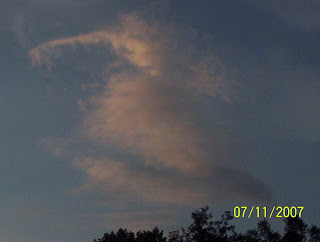Wind Instrument Design
My anemometer measuring the outrushing wind of a collapsing thunderstorm. Though my instrument is fairly accurate, it still has many design flaws.
Image by: Justin Reid 9/27/2007
The advent of the wind measuring anemometer made specific wind measurements possible. The anemometer is a 3 or 4 cup rotating device on a short rotating shaft, that measures the wind. Since then, many manufacturures, agencies, and government sources have made anemometers or deviations from the anemometer. Though not all of these devices are made alike
The first type of wind device I will evaluate is the anemometer itself. The classic form of an anemometer is quite simply the standard. But the accuracy of certain anemometers can be far off.

The National Weather Service, ASOS or Automated Surface Observation System. A single station shown above, it uses a classic 3 cup anemometer that is the standard. A wind vane is also present on the t-shaped split column.
Image courtesy: www.weather.gov
The ASOS implies a 3 cup anemometer with a vertical shaft. The shaft design is what makes the anemometer accurate and the ASOS measuraments reliable. Other devices, even my own anemometer, are flawed because of their upside-down design; facing downward
My anemometer in another collapsing thunderstorm a year ago. As seen before, the upside-down facing design makes the anemometer flawed in one direction.
Image by: Justin Reid 6/4/2007
Other wind instruments have been formulated, some are deviations of the anemometer and others are even sonic in nature, but the best out of all the deviations, in my opinion, is a device called the aerovane.

A Rainwise weather station. One of the most expensive and accurate weather stations in the private market, it utilises an aerovane as it's wind speed and direction indicator.
Image Courtesy: www.rainwise.com
An aerovane was originally made by a branch of the armed forces, but it is now made by several private companies (such as Rainwise). The aerovane system is basically the final advancement of direct wind measurement. It combines both the wind-vane and the anemometer together in one unit. This makes the most dominant wind in the area measured, because the aerovane's body (like a wingless airplane) points to the direction of the greatest wind. The impeller (propeller in reverse) measures the wind that the aerovane is pointing to. The National Weather Service still relies on the 3 to 4 cup anemometer for their measurements, but I am a fan of the aerovane, since it greatly reduces crosswind measurement errors in the output of the device. Though the device isn't as sensitive to wind as an anemometer.
Each wind device has been made through many years of scientific reasearch, maybe someday all wind measurements will be made through indirect observations. In the meantime however, there are several options of direct wind measurement. All have their advantages and disadvantages. The right wind instrument is the one that you feel is best. That is very subjective.
A fiery sunset after a frontal passage. Note the slight waving motion of the cirrus cloud near the horizon called Kevin-Hemholtz Waves.
Image by: Justin Reid 7/13/2007




















